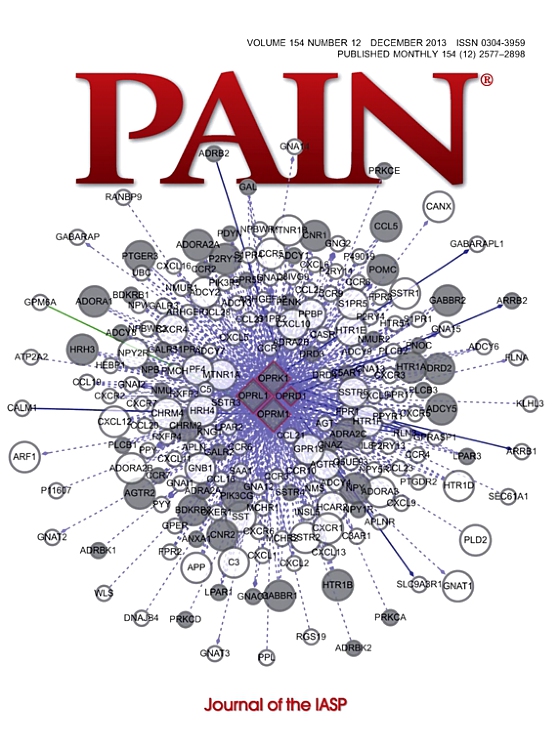19例小纤维神经病的微神经造影研究。
IF 5.9
1区 医学
Q1 ANESTHESIOLOGY
引用次数: 0
摘要
小纤维神经病(SFN)被定义为Aδ和C纤维功能障碍或变性,导致温度感知受损和自发性神经性疼痛。我们采用微神经造影(MNG)分析19例SFN患者的c -伤害感受器特性。c -伤害感受器分为机械敏感和机械不敏感,以及“正常”、“过度活跃”和“缺乏活跃”。结果与定量感觉测试(QST)、表皮内神经纤维密度(IENFD)、持续自发性疼痛(OSP)和电正弦刺激(eSS)评分进行比较。在17例SFN发生OSP的患者中,我们观察了病理伤害感受器。我们发现,当检查区域(脚上)存在OSP时,过度活跃的伤害感受器的比例显著增加(OSPF);然而,在个体水平上,OSP评级与过度活跃纤维比例之间没有显著相关性。OSPF组eSS的疼痛评分较高,且与MNG中过度活跃神经纤维的比例相关。总之,自发活动和机械致敏的C-伤害感受器,主要是机械不敏感的C纤维(CMi),是持续疼痛的潜在生物标志物。由于CMi功能不通过IENFD或QST进行评估,但与OSPF和eSS评分相关,这些测量可能成为表征SFN的有价值的工具,因为它们评估了SFN中自发持续疼痛相关的伤害感受器病理。微神经造影显示c -伤害感受器功能障碍超出常规测试,如QST或IENFD。微神经造影和电正弦刺激的分级可能有助于诊断未改变的QST和IENFD病例中的c -伤害感受器功能障碍,并有助于深入了解过度活跃的c -伤害感受器在持续神经性疼痛中的作用。本文章由计算机程序翻译,如有差异,请以英文原文为准。
Microneurographic portrait of 19 patients with small fiber neuropathy-A pilot study.
Small fiber neuropathy (SFN) is defined by dysfunction or degeneration of Aδ and C fibers, causing impaired temperature perception and spontaneous neuropathic pain. We performed microneurography (MNG) to analyze C-nociceptor properties in 19 patients with SFN. C-nociceptors were classified as mechanosensitive or mechano-insensitive, and either "normal," "hyperactive," or "hypoactive." Results were compared with quantitative sensory testing (QST), intraepidermal nerve fiber densities (IENFD), and ratings of ongoing spontaneous pain (OSP) and electrical sinusoidal stimulation (eSS). In 17 patients with SFN experiencing OSP, we observed pathological nociceptors. We found a significantly greater proportion of hyperactive nociceptors whenever OSP was present in the examined area-on the foot-(OSPF); however, on an individual level, there was no significant correlation between the rating of OSP and the proportion of hyperactive fibers. Pain ratings of eSS were higher in the OSPF group and correlated with the proportion of hyperactive nerve fibers in MNG. In conclusion, spontaneous activity and mechanically sensitized C-nociceptors, predominantly mechano-insensitive C fibers (CMi), are potential biomarkers for ongoing pain. As CMi functionality is not assessed via IENFD or QST, but correlated with OSPF and ratings of eSS, those measures might become valuable tools to characterize SFN because they assess nociceptor pathology relevant for spontaneous ongoing pain in SFN. Microneurography reveals C-nociceptor dysfunction beyond conventional testing such as QST or IENFD. Microneurography and rating of electrical sinusoidal stimuli may aid in diagnosing C-nociceptor dysfunction in cases with unaltered QST and IENFD and offer insights into the role of hyperactive C-nociceptors in ongoing neuropathic pain.
求助全文
通过发布文献求助,成功后即可免费获取论文全文。
去求助
来源期刊

PAIN®
医学-临床神经学
CiteScore
12.50
自引率
8.10%
发文量
242
审稿时长
9 months
期刊介绍:
PAIN® is the official publication of the International Association for the Study of Pain and publishes original research on the nature,mechanisms and treatment of pain.PAIN® provides a forum for the dissemination of research in the basic and clinical sciences of multidisciplinary interest.
 求助内容:
求助内容: 应助结果提醒方式:
应助结果提醒方式:


